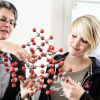Careers pursued by former Jugend forscht competitors
The “Jugend forscht” youth science competition fosters budding scientists.

Carina Lämmle was just 16 when she first faced an audience of students at Biberach University of Applied Sciences in the German state of Baden-Württemberg. Calmly and confidently, she explained to the students, her elders by some years, how a mass spectrometer is operated – a device that sorts and counts chemical particles by weight. She was already well versed in the technology, having discovered an interest in this field a number of years earlier at the Schülerforschungszentrum Südwürttemberg, a school research centre. Together with two project partners and using a device she developed herself, she was investigating a chemical process that separates compounds into their constituent parts. She applied the results to her apparatus, thereby enhancing the separation process. She submitted her idea to the “Jugend forscht” competition in 2011. The young scientists impressed the jury and won the nationwide category for “best interdisciplinary work”. A short while later Carina Lämmle took part in a guided tour of Biberach University of Applied Sciences, where without further ado the dean of the pharmaceutical biotechnology faculty invited her to join his team.
Research by more than 200,000 young people
This is precisely the idea of “Jugend forscht”: to foster talented young people at the earliest possible stage, to familiarize them with the latest methods and to pave the way for them to enter research or industry. The competition was initiated in 1965 by the then editor-in-chief of “Stern” magazine, Henri Nannen. Today it also enjoys the support of the Federal Government, schools and industry. Over the past decades, more than 200,000 youngsters have taken part in this competition, which is aimed solely at science subjects. The majority of the competitors later embarked on a course of scientific, technological, mathematical or medical study, and many went on to pursue careers in research and development. Some even set up a company based on their winning “Jugend forscht” idea. One of these is Daniel Gurdan. Having submitted seven projects, he is one of the competition’s most successful participants. One of the ideas he developed was for a “hobby quadrocopter” – a small helicopter with four rotors. Together with other former “Jugend forscht” entrants, he founded the company Universal Flying Objects in 2006. Just a year later he followed up with Ascending Technologies GmbH, a company that develops and sells small aircraft for universities and professional users in the fields of photography, industry and research.

